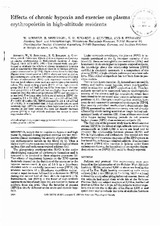Effects of chronic hypoxia and exercise on plasma erythropoietin in high-altitude residents
Fecha
1993Autor
Schmidt, W
Spielvogel, H
Eckardt, KU
Quintela, A
Peñaloza, R
Metadatos
Mostrar el registro completo del ítemResumen
Abstract
The present study was performed to evaluate the effects of chronic inspiratory hypoxia and its combination with physical exercise on plasma erythropoietin concentration ([EPO]). Eight natives from the Bolivian Plateau were investigated at 3,600 m above sea level at rest as well as during and up to 48 h after exhaustive exercise (EE) and 60 min of submaximal (60%) cycle ergometer exercise (SE). Ten sea-level subjects were used as a control group for resting values. The mean resting plasma [EPO] of the high-altitude group (19.5 +/- 0.7 mU/ml) did not differ from that of the sea-level group (18.1 +/- 0.4 mU/ml) but was higher than would be expected from the relationship between [EPO] and hematocrit at sea level. Five hours after both types of exercise, [EPO] decreased by 2.1 +/- 0.8 (EE, P < 0.01) and 1.6 +/- 0.8 mU/ml (SE, P < 0.05); 48 h after SE, [EPO] increased by 2.6 +/- 0.9 mU/ml (P < 0.05). It is concluded that 1) high-altitude natives need relatively high [EPO] to maintain their high hematocrit and 2) exercise at low basal arterial PO₂ does not directly increase plasma [EPO] in high-altitude residents but seems to exert suppressive effects.

